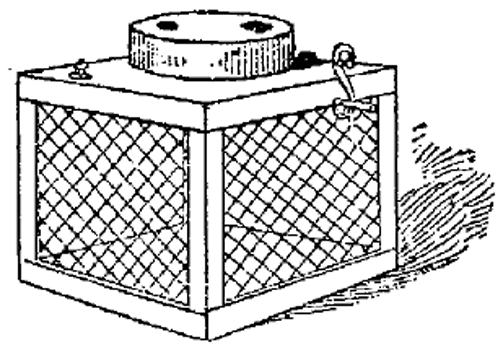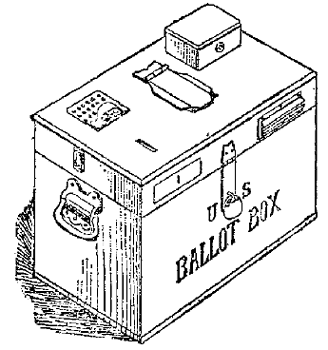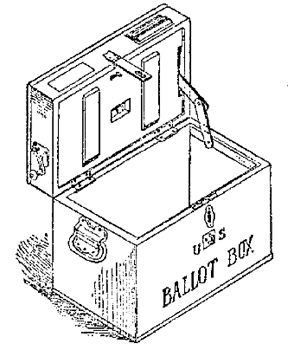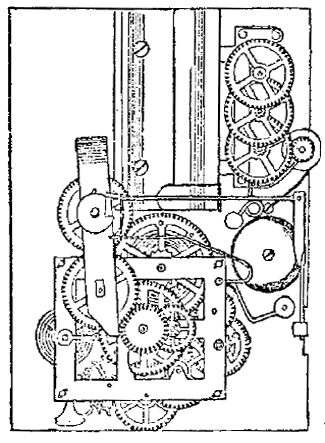[Newspaper]
Publication: The Massillon Weekly Independent
Massillon, OH, United States
vol. 26, no. 45, p. 7, col. 1-3
SOME NEW BALLOT BOXES.
WALTER WELLMAN LEARNS ABOUT
THEM IN THE PATENT OFFICE.
The Subject is Rendered Especially Appropriate
by Reason of the Present General
Interest in the Subject of Ballot
Reform — The Cherokee Ballot,
[Special Correspondence.]
WASHINGTON, April 18.—Three or four states have recently passed ballot reform laws, and in other states proposed laws are still pending in the legislatures. It is a singular fact that one of the most perfect election laws in this country, or at least one which brings best results in absence of frauds and corruption where used, was enacted by Indians for the control of Indian elections. In some of its features the election law of the Cherokee nation, that little republic within our greater republic, resembles the famous Australian law now being used as a model by the ballot reformers of America.
 |
| NEW JERSEY BALLOT BOX. |
John W. Bushyhead, formerly chief of the Cherokee nation, has spent the winter in Washington watching the interests of his people in the Oklahoma question, and many people on meeting Mr. Bushyhead here were amazed to discover that, though an Indian, he wears neither blanket nor head feathers, and is, withal, a modest, intelligent gentleman, speaking English perfectly, and wearing such clothing as other gentlemen wear. In this he is not in advance of his countrymen, almost all of whom speak and read and write English, take English newspapers and magazines, teach English exclusively in their schools, play pianos and organs in their pretty homes, which are neatly carpeted and decorated, and altogether maintain a civilization in nowise differing from that of their neighbors in Kansas, Missouri or Texas. Referring to the election laws of his nation, ex-Chief Bushyhead said:
"We have never had any election frauds or troubles in our nation. Our election law is perfect for our use, though I suppose it is too simple for the requirements of more complex political communities. Our elections for principal chief, assistant principal chief, members of the national council and other officers are held on the first Monday in August. Every male citizen, 18 years old or upwards, a resident of the district six months, of sound mind and not convicted of a felony, is allowed to vote. You will notice that a young man of 18 or 19 can vote with us, because we believe a youth of that age as competent to cast an intelligent ballot as the average citizen of more mature years. Our young men are naturally better educated than our older men, and are quick, bright and thoughtful.
"Ten days prior to tho election the clerk of the district appoints two clerks and two superintendents of election, and furnishes them with blank rolls and envelopes, he must also post in some conspicuous place in every precinct in his district the names of all persons put in nomination for office. The rolls used in elections state the offices to be filled, the names of candidates, with blank spaces for recording the votes cast for each. After taking their oaths the clerks and superintendents appoint and swear in three supervisors, the duties of these supervisors being to keep peace at the polls.
 |
| PATENT SAFETY REGISTERING BALLOT BOX. |
"The first duty of the supervisors is to measure, mark and rope off in the open air a space of fifty feet encircling the polls, and within this circle no person not an officer of the election is permitted to come, except for tho purpose of voting, and then only one voter at a time. Each voter, after casting his vote, is required to retire beyond the prescribed limit. We use no ballots or boxes, and hence, of course, do not have secret voting. The voter steps up, names the candidates for whom he wishes to vote, and the clerks, after reading his name, tally one to the credit of each candidate named. If the voter asks to have it done, one of the officers of the election must read off aloud the names of all the candidates for the various offices. The election officers are forbidden under penalty to seek to influence or bias voters. If any person present himself as a voter whom the officers suspect to be not qualified they must challenge his right, and he has then and there an opportunity to be sworn and give testimony, and also to offer other evidence. After both sides have been heard the superintendent must decide the question, and a list must be kept of all persons whose votes are challenged and finally accepted, and also all who are challenged and not permitted to vote, with a statement showing the names of the candidates whom such voter would have voted for had he been given a chance.
"We have perfected order at our elections, the supervisors having power to summon to their assistance as many persons as they may require to prevent any threatened breach of the peace. They must see that no intoxicating liquors are sold or drunk in the election district, though this part of the law gives little trouble, for intoxicating liquors are not trafficked in anywhere in our nation. Our laws severely punish all who attempt fraudulent voting, or bribery, or interference with the voters, or the conduct of tho election, or tampering with the returns, or making of false entries on the rolls. If three or more persons conspire to disturb or break up an election, and attempt to do so with deadly weapons, they are deemed guilty of treason, and, on conviction, are sentenced to death by hanging.
"We have not a secret ballot," concluded the ex-chief, "and I am glad we have not. I cannot understand why a man should be ashamed to cast an open vote. It is the secret ballot that gives opportunities for corruption and bribery, and there is no bribery among the Cherokees."
Nearly two hundred ballot boxes have been patented in the United States patent office. Only three or four of these patented devices were ever brought into actual use. Some of these ballot boxes are intricate and delicate mechanisms, while others are very simple. Some are as big as printing presses, while others look like rat traps. Among the latter is the box known as the New Jersey box, from the fact that the New Jersey legislature some time ago authorized the purchase of several thousand of its type. It is also used in Cincinnati and some other towns. The boxes cost $25 each, but are warranted sure death to ballot box stuffing. They are about a foot and a half square, with sides of plate glass protected by heavy wire in such manner that even if the glass is shattered the wires hold the broken pieces in place. There are three locks on the box, two of them combination and one a plain lock. The combinations and key are divided among judges and clerks of opposing political parties, the mayor, county judge or other officials holding both combinations and a duplicate key. In use the voter hands his ballot to one of the judges, who inserts it in the opening while another judge turns the rank. As the ballot disappears a bell rings, and a printing mechanism marks the ballot with its number or other device in red ink, and the slip of paper then falls into the bottom of the box, where, with its predecessors, it is plainly visible. If on the count two ballots are found folded together, or a ballot not marked with the red stamp, it is thrown out as fraudulent, because the mechanism will mark but one ticket at a time, and that, of course, tho outside one. As originally designed, this machine was intended to number the ballots consecutively, but that would not do for the reason that it destroys the secrecy of the ballot, inasmuch as comparison of the number of a ticket with the poll sheet would reveal the candidates for whom any given voter had cast his preference.
 |
| REGISTERING BALLOT BOX. |
Nearly all of the patented ballot boxes, or voting machines, as the patent office calls them, aim at similar results. The turning of a crank, marking or numbering of the ballot, ringing of a gong and detection of double voting are features common to tho vast majority of them. Some novel mechanical methods are employed, and in a few the mechanism greatly resembles that of a town clock. Clocks are actually introduced in several machines, as in the invention of T. R. Hester, of Napa, Cal, whose device calls for an "auto-register signal time lock" on the compartment containing tho ballots, and another similar time lock on the compartment containing the dial plates which record and exhibit the number of votes cast for each candidate.
W. P. Furnell, of Silver Hill, W. Va., patents a machine in which the names of all the candidates are placed on a continuous roll of paper. As such ballot is deposited the clerk "tallies" for each candidate voted for through an aperture, and as soon as this is done the tally sheet moves along out of sight and reach, so that no tallies can be erased or additional marks surreptitiously added.
 |
| HESTER TIME LOCK BALLOT BOX. |
A novel device is that patented by A. C. Carey, of Boston. The ballots are automatically sewn together, end to end, and rolled upon a spool from which they are unwound to be counted. The beginning of the string is an election authorization document; then come the ballots, and finally, at the closing of the polls, comes the certificate of the judges of election, all sewn in one continuous strip.
C. A. Mayrhafer, of Vienna, Austria, patents a strange mechanism for "automatically casting and recording ballots actuated by the pressure or expansion of fluid." Probably Mr. Mayrhafer does not know that elections in this country are already too much influenced by the pressure of certain fluids.
Among a host of other devices, resembling threshing machines, lamps, locomotives, sheep pens, money vaults and employing electricity, balls, marbles, knobs and wires, one more attracts attention. It is the invention of H. W. Synatt, Blackheath, England, and probably is the most comprehensive voting machine ever invented. It is warranted to do everything except pay election bets and furnish the intelligence for discriminative voting. "The voting place is approached by a turnstile," says the inventor. "The voter on entering through this stile unlocks the mechanism and makes it possible for him to vote. There is a knob for each candidate, but the voter can get at but one knob at a time.
"Drawing of this knob locks all the other knobs. After this knob has been pushed back in its place another knob is exposed to view, and so on till all the officers have been voted for. Pulling of a knob registers a vote for the candidate assigned to it, indicates to the voter that his vote is registered, registers the vote on a public index, rings a bell and actuates the entire locking apparatus. As the voter makes his exit through a second stile the mechanism is locked till another voter enters the first stile and thus unlocks it."
This is all very pretty and convenient, but after a voter had pulled knobs for thirty-six presidential electors, a member of congress, two or three senators and representatives in the legislature, judicial, county, city and township officers, perhaps to the number of fifty or sixty in all, he would be in danger of becoming wearied, and the voters awaiting their turn at the stile would be likely to lose patience and commit a fracture of the peace. One wonders that the able inventor did not add a mechanism for promptly arresting and turning over to the police any man who might attempt to pull more than his lawful number of the knobs.
Three or four of the patents embrace devices for automatically displaying, in large figures, the number of votes cast for each candidate, so that at any moment a bystander, by merely glancing at the machine, could tell how his party or favorite candidate was faring. This would greatly facilitate the gathering of election returns for afternoon newspapers, and would often enable them to determine the result of a local election many hours before the closing of the polls. By these devices the ballots are counted as deposited, and when the polls close the result of the day's work is instantly displayed in plain figures. In as much as the use of such a ballot box as this would deprive the free American citizen of his inalienable right of staying down town till midnight of an election evening to hear returns, it is not likely to meet with universal favor.
WALTER WELLMAN.
